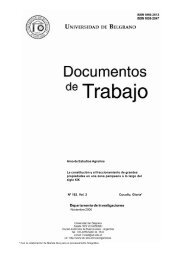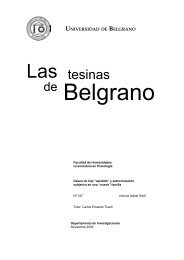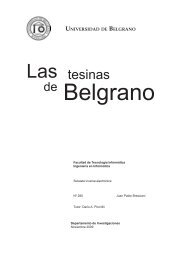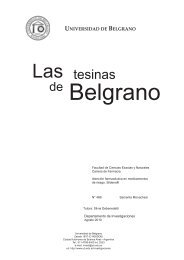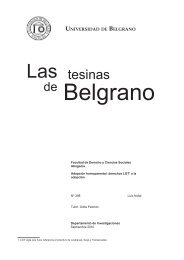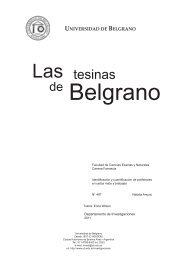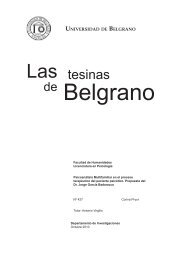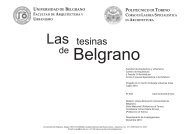GUIA DE EJERCITACION - Universidad de Belgrano
GUIA DE EJERCITACION - Universidad de Belgrano
GUIA DE EJERCITACION - Universidad de Belgrano
You also want an ePaper? Increase the reach of your titles
YUMPU automatically turns print PDFs into web optimized ePapers that Google loves.
7. Cada uno <strong>de</strong> dos vasos <strong>de</strong> vidrio contiene 5,0 dm³ <strong>de</strong> gas i<strong>de</strong>al a 70°C; uno <strong>de</strong> ellos<br />
está a 750 torr y el otro a 730 torr.<br />
Se transfiere la totalidad <strong>de</strong>l contenido <strong>de</strong> uno <strong>de</strong> los vasos al otro aumentando la<br />
temperatura a 120°C. Calcule la presión final.<br />
R. 2,23 atm.<br />
8. Una burbuja <strong>de</strong> aire, <strong>de</strong> 5,00 mm <strong>de</strong> diámetro se eleva <strong>de</strong>s<strong>de</strong> el fondo <strong>de</strong> un lago <strong>de</strong><br />
20 m <strong>de</strong> profundidad.<br />
La temperatura en el fondo es <strong>de</strong> 7°C y en la superficie <strong>de</strong> 27°C.<br />
Calcule el diámetro <strong>de</strong> la burbuja cuando llega a la superficie.<br />
R. 7,33 mm.<br />
9. Se vaporizan 0,55 g <strong>de</strong> un compuesto a 100°C, recogiéndose el gas <strong>de</strong>sprendido<br />
<strong>de</strong>ntro <strong>de</strong> un recipiente <strong>de</strong> 373 cm³ y a 740 torr.<br />
Calcule la masa molar <strong>de</strong>l compuesto.<br />
R. 46,4 g/mol<br />
10. Un cilindro contiene helio a 1470 atm. Se retira una masa <strong>de</strong> gas que ocupa 4,0<br />
dm³ a 14,7 atm. La presión <strong>de</strong>ntro <strong>de</strong>l recipiente es <strong>de</strong> 1400 atm. Calcule el<br />
volumen <strong>de</strong>l cilindro, sabiendo que la temperatura permanece constante.<br />
R. 0,84 dm³.<br />
11. Un recipiente cerrado con un émbolo móvil contiene 16,04 g <strong>de</strong> metano (CH4) a<br />
186,651 kPa y 200°C. Calcule:<br />
a. el volumen <strong>de</strong>l recipiente.<br />
b. la presión si el volumen se reduce a la mitad y la temperatura ascien<strong>de</strong> a<br />
300°C.<br />
c. la presión, si en las condiciones <strong>de</strong>l subítem b se retiran 0,50 moles <strong>de</strong> gas.<br />
R. a. 21,07dm³; b. 451,91 kPa; c. 225,95 kPa.<br />
12. La <strong>de</strong>nsidad <strong>de</strong> oxígeno, en condiciones normales, es 1,43 g dm -3 . Calcule dicho<br />
valor para 17°C y 93,326 kPa.<br />
R. 1,24 g dm -3 .<br />
13. Se tiene tres ampollas conectadas <strong>de</strong> acuerdo con el diagrama, en el estado inicial<br />
que se <strong>de</strong>talla.<br />
Calcule la presión al abrir las llaves, si la temperatura permanece constante.<br />
R. 56,32 kPa.<br />
Serie <strong>de</strong> problemas Química 2004 18



